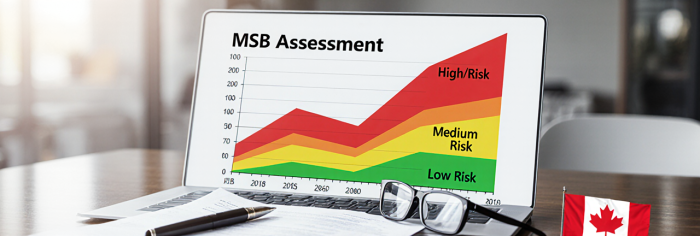Every Money Services Business (MSB) in Canada – including fintech startups, crypto exchanges, and other financial service providers – must maintain a robust Anti-Money Laundering (AML) compliance program under FINTRAC (Financial Transactions and Reports Analysis Centre of Canada) oversight. The Proceeds of Crime (Money Laundering) and Terrorist Financing Act (PCMLTFA) and its regulations mandate that all reporting entities implement a compliance program with five core components. These five “pillars” form the foundation of an effective AML/ATF (Anti-Terrorist Financing) regime for your business. They include:
Failure to implement all five pillars is not only a legal violation but also puts your company at risk of regulatory penalties and financial crime exposure. Below, we break down each pillar with practical guidance on how to meet Canadian requirements, followed by a summary table and a readiness checklist.
To set the stage, the table below summarizes the five pillars of an MSB’s AML compliance program in Canada and the key requirements for each:
|
Pillar |
Key Requirements & Components |
|
1. Compliance Officer |
Designate an AML Compliance Officer with sufficient authority and knowledge. This person should be senior enough to have independent oversight and direct access to leadership. They must understand the business’s operations, sector risks, and legal obligations, and have the mandate to implement changes. |
|
2. Written Policies & Procedures |
Develop written, up-to-date AML policies approved by senior management. Cover all required areas: KYC (client identification, beneficial owners, PEPs), ongoing monitoring of client transactions, record-keeping, transaction reporting (e.g. Suspicious Transaction Reports, Large Cash or Virtual Currency transactions), and special measures for high-risk situations (enhanced due diligence, travel rule for fund transfers). Tailor the procedures to your business’s size, services, and risks (avoid one-size-fits-all templates). |
|
3. Risk Assessment |
Conduct and document a thorough risk assessment of your business’s exposure to money laundering/terrorist financing. Consider factors like your clients and business relationships, the products/services and delivery channels you offer, the geographic regions of your operations or customer base, and any new technologies or business lines. Identify high-risk areas (e.g. certain client profiles or countries) and apply enhanced measures to mitigate those risks. Update the risk assessment whenever you introduce new products or see significant changes. |
|
4. Training Program |
Implement an ongoing AML training program for all relevant personnel (employees, agents, etc.). Training should cover the business’s obligations under Canadian law, the basics of money laundering/terrorist financing and how to recognize “red flags,” your internal policies/procedures, and employees’ roles in compliance. Deliver training at least annually (and for new hires or when regulations change), and maintain records of training sessions (dates, attendees, topics) to evidence compliance. |
|
5. Effectiveness Review |
Conduct an independent review of your AML program at least every two years to test that it’s working effectively. This can be done by an internal or external auditor or qualified person not directly involved in daily compliance duties (to ensure impartiality). The review should cover all program elements (policies, risk assessment, training, reporting, etc.), sample transactions and records, and verify that what’s on paper is being practiced. Document the results and report any deficiencies and updates to a senior officer within 30 days of completion, then promptly address any issues found. |
Next, we delve into each pillar in detail and provide practical steps to fulfill each requirement.

The Compliance Officer is the cornerstone of your AML program. Canadian law requires every reporting entity to appoint a person responsible for implementing the compliance program. In a startup or small fintech, this might be the founder or another senior manager; larger companies should appoint a dedicated compliance professional at the senior leadership level. FINTRAC guidance suggests the compliance officer should not be directly involved in handling day-to-day financial transactions, to avoid conflicts, and must have a direct line to senior management or the board. This ensures they have the independence and authority to enforce compliance measures.
Qualifications and Authority: Your compliance officer should have:
In practice, a compliance officer’s duties include developing and updating policies, overseeing client onboarding/KYC, monitoring transactions for red flags, filing regulatory reports (e.g. Suspicious Transaction Reports to FINTRAC), training staff, and liaising with regulators or auditors. The appointed officer remains accountable for the program’s implementation even if certain tasks are delegated to other employees. It’s wise to formalize the appointment in writing (e.g. a board resolution or letter) and include a job description outlining the responsibilities and reporting lines.
Best Practice: Choose a compliance officer who is trustworthy and has an eye for detail. Given the complexity of AML requirements, this person should ideally stay current with regulatory updates and ongoing training themselves. If your team lacks a qualified individual, consider external help or consulting services to fulfill this role temporarily while you train someone internally. Remember that FINTRAC will hold your business accountable for compliance – having a strong compliance officer at the helm is your first line of defense.

Formal written policies and procedures are required to operationalize your AML program. Think of these as the rulebook for how your organization will meet each of its compliance obligations. Under Canadian regulations, MSBs must develop and apply written compliance policies that are kept up to date and approved by a senior officer (for companies). All staff should have access to these procedures so they know their duties in preventing money laundering.
What to include: FINTRAC expects your policies and procedures to comprehensively cover all applicable obligations of the PCMLTFA and its regulations. At minimum, ensure that your written program addresses:
Crucially, your policies must also describe operational controls – the “how” you implement these obligations. For example, explain how your staff conducts identity verification (in-person or using tech solutions), how transactions are reviewed (manually, automated software rules, etc.), who approves exceptions, and escalation procedures for potential suspicious activity. Document timelines as well: e.g., STRs must be filed “as soon as practicable” after suspicion is formed, which FINTRAC expects to be promptly prioritized.
Tailor to your business: Avoid the mistake of using a generic policy template without customization. FINTRAC explicitly requires that your program be tailored to the type, size, and complexity of your business and the specific risks you face. For instance, a small currency exchange with a local client base might have simpler procedures than a national crypto exchange serving thousands of users online – and that’s okay, as long as all required bases are covered. If you adopted an industry association’s template, be sure to modify it to fit your actual operations. During FINTRAC examinations, officers will check if what you do in practice matches your written procedures, and if those procedures are adequate for your risk level.
Finally, keep the compliance manual up to date. Assign responsibility (often the compliance officer) to review the policies periodically and whenever laws change or new products are launched. Changes in regulation (for example, new identification methods or reporting thresholds) should be reflected promptly. Senior management should re-approve major updates, signaling top-level commitment. Keeping a version history or revision log is a good practice to demonstrate this ongoing maintenance.

An AML program must be risk-based. This means your controls should be commensurate with the level of money laundering/terrorist financing risk your business faces. To achieve that, you need to conduct a formal Risk Assessment of your MSB. Canadian regulations require every reporting entity to assess and document the risk of an ML/TF offense occurring in the course of their activities. In other words, you must identify where and how your business could be misused for illicit finance, and then take steps to mitigate those risks.
Key elements of a risk assessment: FINTRAC expects your risk assessment to consider several factors, covering virtually all aspects of your operations:
Once you’ve identified risks in each category, rate the risk (e.g. low, medium, high) and document the rationale. For instance, you might rate “cash transactions over $10k” as high risk due to regulatory thresholds and the potential for anonymity, and note you have few such transactions monthly. Another example: “Clients from XYZ country – high risk due to sanctions and corruption index”. Documentation is critical; FINTRAC will review your risk assessment document to ensure it’s thorough and rational.
Mitigation and enhanced measures: For each high-risk area identified, you must implement enhanced measures to mitigate the risk. Enhanced measures (also called Enhanced Due Diligence) are stronger controls beyond the standard. For example: requiring senior management approval for onboarding a high-risk client, collecting additional identity documents or information on source of funds, conducting more frequent transaction monitoring or periodic reviews of the client’s activity, and updating KYC information more often. Your policies should specify what extra steps to take for high-risk cases (this was mentioned under Policies above).
For instance, if your risk assessment flags “cryptocurrency transactions with mixers” as high risk, an enhanced measure might be to prohibit interacting with mixers or require proof of source of coins from those clients. If “international students sending wire transfers to high-risk countries” is a scenario, you might verify the purpose of funds and require additional documentation. Essentially, acknowledge the risk and show you have a game plan to handle it.
Keep it current: A risk assessment is not a one-and-done document. Review it at least annually, and whenever there are major changes such as entering a new market or offering a new service. Also, if something triggers a lot of suspicious activity reports or a regulatory red flag, reconsider your risk ratings – perhaps something you thought low risk is higher in reality. FINTRAC can ask for evidence that you incorporated new information (like the latest typologies or guidance) into your risk assessment.
In summary, the risk assessment is your roadmap to allocate compliance resources wisely: more effort where risk is highest, and not over-burdening low-risk areas. It also demonstrates to regulators that you understand your business and are proactive in mitigating threats. Many companies use a risk matrix or chart for this purpose, but choose any format that clearly conveys the above points.

Even the best policies won’t work if your team doesn’t know about them. That’s why an ongoing training program is the fourth pillar of AML compliance. Canada requires every reporting entity with employees or agents to implement a written training program and have a plan for delivering that training. The goal is to ensure that everyone involved in your operations understands their AML obligations and can effectively spot and respond to risks.
Who must be trained: All persons involved in your business operations should receive training appropriate to their role. This includes: front-line staff who interact with customers or handle transactions, back-office staff who might see transaction data, compliance personnel, senior management who oversee operations, and even the board of directors as needed. If you use independent agents or contractors (for example, an independent remittance agent), they must be trained as well, since they act on your behalf. Essentially, anyone who could encounter a suspicious transaction or is responsible for applying your policies should not be left in the dark.
For fintech or crypto companies, “who” includes software engineers or IT staff that implement KYC/monitoring systems – they need to know the importance of certain features. It also includes customer support teams who might field ID documents or account questions. The compliance officer and those administering the program should perhaps get more advanced training (like external courses or certifications) in addition to internal training.
What the training covers: FINTRAC guidance lists a number of topics that your training should encompass:
How and how often to train: Your training plan (a documented plan is required) should outline training methods, frequency, and materials. Common practice is to provide training at least annually for all staff. Many companies use annual refresher courses (in-person seminars, webinars, or online modules) coupled with shorter updates when something changes. Additionally, new employees should receive AML training before they start dealing with clients or soon after onboarding.
Training can be delivered in various formats – e-learning modules, live workshops, lunch-and-learns, quizzes, etc.. Small firms might do a simple in-person briefing, whereas larger ones might have interactive online courses. The key is effectiveness: choose methods that ensure the information is understood and retained.
Be sure to document all training activities. Maintain records showing the date of training sessions, who attended (or completed the module), and what topics were covered. These records demonstrate to FINTRAC that you are fulfilling the ongoing training obligation. If you use an external training provider or attend conferences, keep proof of attendance and content.
Also, tailor training depth according to roles. For example, frontline staff might get more focus on identifying ID documents and suspicious behaviors, whereas your board of directors might get an overview of program effectiveness and their governance role. The compliance officer and team might pursue specialized training (like certifications or detailed workshops) given they manage the program.
Continuous improvement: Solicit feedback or test employee knowledge (quizzes or scenario discussions) to gauge the training’s effectiveness. If gaps are identified (e.g., employees still uncertain about certain procedures), update the training content or frequency. As regulations evolve (for instance, new STR guidance or sanction lists), include those updates in the next session or send memo updates. A culture of compliance is reinforced by regular and meaningful training – it shouldn’t be a checkbox exercise but rather an empowering tool so employees feel capable of contributing to risk mitigation.

The fifth pillar is the effectiveness review, essentially an audit of your AML compliance program that must be conducted on a regular cycle. Canadian regulations specify that you must institute a plan for a review of your compliance program’s effectiveness and carry out this review at least every two years. This is sometimes referred to as a biennial independent review or audit. Its purpose is to critically evaluate whether your compliance program is working as intended and to identify any gaps or weaknesses.
Who conducts the review: The review can be done by an internal or external auditor, or by yourself if you don’t have an internal auditor. However, to ensure impartiality, the reviewer should be independent of the day-to-day compliance management. This means you should not have your currently appointed compliance officer audit their own work – that would lack objectivity. Many small MSBs hire an external consultant or auditor with AML expertise to perform the effectiveness testing. Larger companies might use their internal audit department or compliance committee, provided those individuals are not the same people who run the program. The person(s) doing the review should be knowledgeable about Canada’s AML requirements and your business’s obligations.
Scope of the review: Your documented plan should outline that the review will cover all elements of the compliance program – policies and procedures, the risk assessment, training program, and how well each of these are implemented in practice. It should also evaluate your reporting and record-keeping performance. In practice, an effectiveness review often includes:
Documentation and reporting: After conducting the evaluation and testing, the reviewer must document the findings in a written report. For an entity (company), the law requires that within 30 days of completing the review, its findings are reported to a senior officer (e.g., CEO, board, or senior compliance executive). The report should include any deficiencies or gaps identified, as well as recommendations and an action plan to fix them. For example, a finding might be “Incomplete beneficiary info on some wire transfer records – recommend updating procedures and training on travel rule compliance.” The report should also note any updates made to policies/procedures during the period under review, and whether those were implemented effectively.
It’s crucial not to treat this as a mere formality. FINTRAC examiners will often ask for your latest effectiveness review report. They want to see that you have taken the results seriously – i.e., you addressed the identified issues. A review that finds nothing every time might be less credible; it’s normal to discover areas to improve, especially as regulations evolve or business grows. What regulators want to see is that you acted on those findings. For instance, if the review noted that training frequency was insufficient, by the time of a FINTRAC audit you should have increased training and be able to show that change.
Frequency: The minimum is every two years, but you can do it more frequently if your risk warrants it. High-growth fintechs or crypto companies sometimes opt for annual reviews, since their business models evolve quickly. Additionally, if a major compliance failure is discovered or there are regulatory changes, an out-of-cycle review might be prudent. Keep in mind, two years is counted from the start of the previous review (FINTRAC expects you to start the next review within 24 months of the last’s start date). Don’t delay it – mark your calendar and budget for it.
Engaging an independent professional (like an external auditor or consultant) to do the effectiveness test can provide extra credibility and insights. They can often benchmark your program against industry best practices. MapleBiz, for example, offers independent AML compliance reviews and can help ensure your program meets all FINTRAC expectations (more on that below).
With each of the five pillars established – Compliance Officer, Policies, Risk Assessment, Training, and Independent Review – your MSB will have a solid defense against financial crimes and be well-prepared for FINTRAC examinations. To help you double-check your readiness, use the following checklist as a quick reference.

Use this checklist to verify that your Canadian MSB’s compliance program addresses all five core pillars and related obligations. If you can tick all these boxes, you’re on the right track:
If any of the above items are missing or incomplete, your compliance program may not meet FINTRAC’s standards. It’s wise to remedy those gaps as soon as possible – not only to avoid penalties but to protect your business from being misused by criminals.
Building a strong AML compliance program may seem daunting, but it’s absolutely manageable with the right approach – and it’s non-negotiable for doing business as an MSB in Canada. By focusing on these five pillars – a responsible compliance officer, robust policies, a thorough risk assessment, continuous training, and regular independent reviews – you create a culture of compliance that safeguards your company’s integrity and reputation. Remember, effective AML compliance isn’t just about satisfying FINTRAC; it also helps you know your customers better, prevent fraud, and build trust with banking partners and customers.
Need help strengthening your AML compliance program? MapleBiz is here to support you. Our team of compliance experts specializes in Canadian MSB requirements and can assist you with everything from drafting custom policies to conducting independent two-year effectiveness audits. Whether you’re launching a new fintech venture or looking to enhance an existing program, we provide clear, practical guidance every step of the way.
Contact MapleBiz today to ensure your AML program not only meets FINTRAC obligations but becomes a competitive advantage for your business. We’ll help you navigate the regulations confidently and keep your company safe and compliant in Canada’s evolving financial landscape. Let us partner with you in building a rock-solid compliance foundation – so you can focus on growing your business with peace of mind.